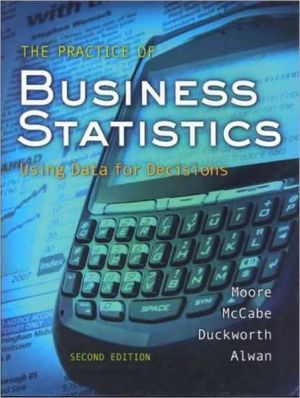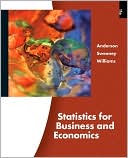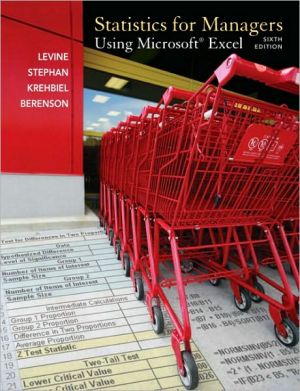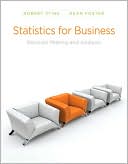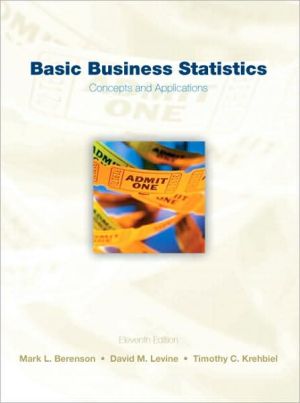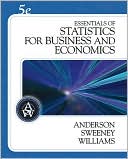Practice of Business Statistics : Using Data for Decisions
The Practice of Business Statistics offers a welcome innovation by allowing students to make data-informed, real-world business decisions almost from day one. By discussing data production and interpretation early in the book data analysis can then be used throughout the course. This approach drives home the relevance and usefulness of statistical ideas to the business world from the onset.\ New Format Options\ The Practice of Business Statistics responds to concerns about textbook length by...
Search in google:
The Practice of Business Statistics offers a welcome innovation by allowing students to make data-informed, real-world business decisions almost from day one. By discussing data production and interpretation early in the book data analysis can then be used throughout the course. This approach drives home the relevance and usefulness of statistical ideas to the business world from the onset. New Format OptionsThe Practice of Business Statistics responds to concerns about textbook length by offering instructors a number of alternatives:A core book containing the first 14 chaptersCompanion chapters on advanced inference topics (available on the book companion site, or through W.H. Freeman Custom Publishing):15. Two-Way Analysis of Variance16. Nonparametric Statistics17. Logistic Regression18. Bootstrapping Methods and Permutation Tests
Because real data are often messy and inference requires clean data, data analysis is an essential preliminary to inference. That is why data analysis is presented first, as Part 1.Part I Data Chapter 1 Examining Distributions 1.1 Displaying Distributions with Graphs 1.2 Describing Distributions with Numbers1.3 The Normal Distributions The first of two Chapters on data analysis: shows students how to look at data and summarize them graphically and numerically, introducing sampling distributions, repeated samplings, and standard deviation.Chapter 2 Examining Relationships 2.1 Scatterplots2.2 Correlation 2.3 Least-Squares Regression 2.4 Cautions about Correlation and Regression 2.5 Relations in Categorical Data The second Chapter on data analysis: shows students how to analyze and summarize, graphically and numerically, data with two variables, introducing relationships between variables, correlation, and providing a preliminary introduction to least-squares regression.Chapter 3 Producing Data 3.1 Designing Samples3.2 Designing Experiments 3.3 Toward Statistical Inference 3.4 NEW Commentary: Data Ethics Teaches students to look more deeply at where data sets come from and how to recognize good data from bad data.Part II Probability and Inference Chapter 4 Probability and Sampling Distributions4.1 Randomness 4.2 Probability Models 4.3 Random Variables4.4 The Sampling Distribution of a Sample MeanThe probability material that is needed to understand statistical inference.Chapter 5 Probability Theory5.1 General Probability Rules5.2 The Binomial Distributions 5.3 The Poisson Distributions5.4 Conditional Probability Additional probability material in a more traditional manner; optional.Chapter 6 Introduction to Inference6.1 Estimating with Confidence6.2 Tests of Significance 6.3 Using Significance Tests6.4 Power and Inference as a Decision From Chapter 6 on, the book presents statistical inference, still encouraging students to analyze the data rather than quickly choosing a test from Excel.Chapter 7 Inference for Distributions7.1 Inference for the Mean of a Population 7.2 Comparing Two Means 7.3 Optional Topics in Comparing Distributions Chapter 8 Inference for Proportions8.1 Inference for a Single Proportion8.2 Comparing Two Proportions Part III Topics in Inference Chapter 9 Inference for Two-Way Tables9.1 Analysis of Two-Way Tables 9.2 Formulas and Models for Two-Way TablesChapter 10 Inference for Regression10.1 Inference about the Regression Model 10.2 Using the Regression Line10.3 Some Details of Regression Inference Chapter 11 Multiple Regression 11.1 Data Analysis for Multiple Regression 11.2 Inference for Multiple Regression 11.3 Multiple Regression Model Building Chapter 12 Statistics for Quality: Control and Capability 12.1 Statistical Process Control 12.2 Using Control Charts 12.3 Process Capability Indexes 12.4 Control Charts for Sample Proportions Chapter 13 Time Series Forecasting13.1 Trends and Seasons 13.2 Time Series Models Chapter 14 One-Way Analysis of Variance14.1 One-Way Analysis of Variance 14.2 Comparing Group Means 14.3 The Power of the ANOVA Test Part IV Optional Individual Companion Chapters Chapter 15 Two-Way Analysis of Variance15.1 The Two-Way ANOVA Model15.2 Inference for Two-Way ANOVAChapter 16 Nonparametric Tests16.1 The Wilcoxon Rank Sum Test16.2 The Wilcoxon Signed Rank Test16.3 The Kruskal-Wallis TestChapter 17 Logistic Regression17.1 The Logistic Regression Model17.2 Inference for Logistic Regression17.3 Multiple Logistic RegressionChapter 18 Bootstrap Methods and Permutation Tests18.1 Why Resampling?18.2 Introduction to Bootstrapping18.3 Bootstrap Distributions and Standard Errors18.4 How Accurate is a Bootstrap Distribution?18.5 Bootstrap Confidence Intervals18.6 Significance Testing Using Permutation Tests
